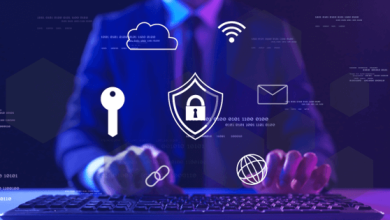Learn how to protect your business from cyberattacks in 2022

Since business owners have to handle several responsibilities simultaneously, they often leave cybersecurity at the end of their priorities list. However, disregarding IT security can affect their business operations – entrepreneurs could face significant dangers unless they take the necessary steps to keep their business safe from cybercriminals’ tactics. The digital world is constantly evolving, and so do hackers’ ways of accessing sensitive information. These individuals with malicious objectives perfect their tactics constantly, which is why business owners must be proactive about cybersecurity.
Hackers constantly look for ways to exploit any weakness in businesses’ cybersecurity procedures, so if you want to prevent a cyberattack, you should ensure your procedures are efficient and up-to-date. A successful cyberattack could result in considerable data loss, customer, employee and proprietary information theft. Hackers utilise an arsenal of online weapons like malware and Trojans to disrupt business operations, and once your system gets infected, it’s challenging to get it to run smoothly again. While antivirus software may help prevent these online threats, you still need to take additional precautions to protect your organisation. With these things in mind, here are seven practical ways to protect your business from a cyberattack in 2022.
Teach employees about cybersecurity
The COVID-19 pandemic has forced employees to switch to remote working, exposing them to online threats and opening organisations to cyberattacks. At the same time, hybrid working has brought its own risks, such as employees using a public Wi-Fi network to complete work-related tasks.
Employees must be upskilled in accessing dangerous websites, falling for digital scams, and transferring data safely. Considering the rise in cyberattacks, ensuring employees understand the importance of cybersecurity is critical. Phishing scams have become prevalent lately, so now more than ever, it is paramount for business owners to teach employees how to stay safe online. Providing regular training is a practical way to do so, where you should teach employees about digital cyber threats and safety measures they can take.
Establish online safety guidelines
Your business should include a cybersecurity policy outlining guidelines for safely accessing the Internet. This policy is a way to shield employees from exploitation and dangers and ensure customers can have a reliable experience. Moreover, the organisation must build secure systems for managing transactions to protect customers from financial loss and identity theft.
Cybercriminals aren’t the only ones to pose threats – risks can also come from former and even actual employees, business partners, rival companies, and poor internal cybersecurity procedures. Therefore, an organisation should set up rules on how workers should utilise company devices, transfer information safely, or share it on websites and social media.
Store data securely
Among other methods, hackers use social engineering. This translates into cybercriminals using public information to manipulate individuals into sharing private data. To avoid this, organisations should limit the amount of online information they share about their employees and business.
What’s more, unsecured data is a welcoming invitation for cybercriminals. They will immediately take advantage of any vulnerability they discover, which could result in significant damage. Therefore, businesses must keep their data secure and do multiple backups to protect sensitive information from cyber theft, destruction, loss and natural disasters. Since not all data storage services are ideal for every business, you should find what works best for your company.
According to Data Breach Claims experts, the UK GDPR states that companies which process personal data should keep it secure. This means you are responsible for preventing threats that could affect your employees’ or customers’ information. Fortunately, it’s possible to do so by putting data protection at the top of your priorities list.
Create complex passwords
Passwords shouldn’t be easy to guess, as they could result in cybercriminals accessing your data. Employees should use strong passwords that combine letters, numbers, and special characters, and companies should opt for passphrases for extra system security. Passphrases are more complex, mixing unrelated, capitalised and lowercase words, special characters and numbers. This makes hackers’ jobs much more challenging, preventing them from breaching an account.
Changing passwords frequently is a critical element of your cybersecurity strategy, and it will help reduce risks by preventing cybercriminals from accumulating passwords from several accounts. Plus, you’ll also limit the damage in case one of the accounts gets breached.
Use two-factor authentication
Two-factor authentication is a standard tool that businesses use nowadays. Here’s how it works: suppose someone wants to log into your account from an unfamiliar device, they won’t be able to do so unless they have an additional authentication source. If they try to guess your passwords, they would need your device to access the accounts.
Two-factor authentication makes it challenging for hackers to steal customer data from business accounts. With cyberattacks rising, it’s paramount to use two-factor authentication to protect your online accounts.
Limit employee access to sensitive information
Employees’ access to sensitive information increases the risk of your business being hacked. About 95% of breaches occur due to human error, and more often than not, employees pose a significant threat.
In most cases, you can put into place restrictions that can prevent over-access to information without inconveniencing employees. Limiting access to sensitive data can help ensure cybercriminals will have a challenging time accessing your company’s data. Moreover, it will also reduce the risk of team members accidentally sharing data with the wrong individuals.
Perform an audit of cybersecurity procedures
You cannot just sit and wait until an attack happens to check if your security protocols work. Instead, you should review the policies and frequently check the systems, servers, cloud solutions and software to ensure your business data is fully protected. Access backed-up data and download it to determine how the recovery process works for your company.
You should also identify vulnerabilities and fix them. Moreover, performing maintenance acts such as removing software you don’t use anymore is essential, as it helps lower the risk of cybercriminals stealing or destroying your information.
Last words
Preventing cybercrime is critical for your venture’s survival. Getting your business back on track after a cyberattack is a tough job that takes a lot of effort, time and money. Moreover, losing customers’ data will harm your brand’s reputation. Following the tips above will help you secure your data and protect your business and customers.











